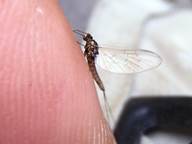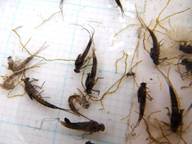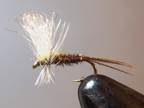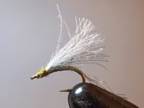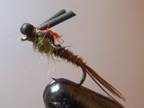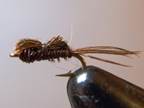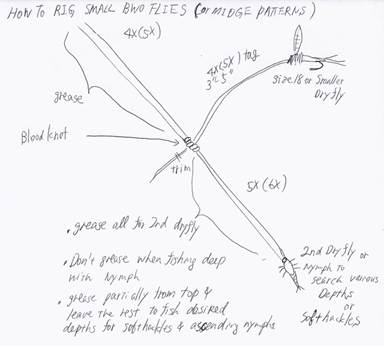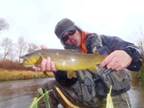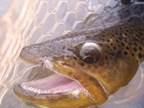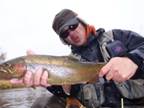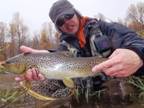BWO HAPPY HOURS, WATERLOO AND SOLUTION
Fall 2012 at DePuy Spring Creek
Prologue
Fall is a glorious time at DePuy Spring Creek (www.depuyspringcreek.com) DePuy Spring Creek is a private, fee fishery and the daily rod fee is lower during the winter and fishing pressure is the lowest this time of the year. Those human factors aside the main attractions are:
- Lots of fall-run brown trout entering the creek for spawning, followed by rainbows, and some of them are really big.
- Fall Blue Winged Olive (Baetis, hereafter to as BWO) hatch is the last major hatch of the year. When the BWO hatch is strong, even those huge spawning run trout also join the rising trout. By then, water level is low (as aquatic weed beds degenerate) and trout have experienced all kinds of flies and tactics, i.e., selective and wary. This situation demands the most skillful anglers at DePuy's, which is always technical and challenging in its own right.
I started well as the fall season opened on October 15th. However, I came across a very special situation. As October went by, suddenly trout and BWO acted differently. I couldn't catch any trout during BWO hatches for next several days as if I was casting from a different dimension. I started feeling paranoid. I observed creek, trout, and bugs. I listened to my guide mentor, Montana's Master Angler himself, Tom Travis. Finally I solved the situation. If I hadn't figured this out before hatch was done for the season, I would still be in the middle of paranoia.
Through this experience, I stepped onto higher level as an angler and developed more observant eyes as a guide. I'd like to share great fall fishing at DePuy's, successful tactics and flies, sudden problems, and solution deduced from my observation. Indeed "spring creek is the classroom of fly-fishing" (my mantra learned from Tom Travis).
PART 1: HAPPY START!!
From October 15th and next several days, trout started feeding sporadically from 12:30 p.m. and BWO were seen one by one. By 1 p.m. the hatch was officially on and continued until 3p.m. (so before and after the hatch I fished with streamers and large soft-hackles and caught lots of nice fish)
One cold day with pouring rain and occasional snow, nothing was really happening even at 1p.m. at "The Bend", one of most popular and productive spots. I waited until 2 p.m. and my perseverance paid off as BWO hatch started in full-swing and trout were rising along the far bank. Some large trout positioned themselves barely a few inches off the overhanging grasses. Casting toward them was a pin-point task and hooking those large trout was very rewarding.
|
|
|
|
|
Stomach sample. |
BASIC TECHNIQUE:
Probably most of experienced spring creek anglers find this important and worth repeating over and over: the most important aspect when casting dry-fly at spring creeks is "angle of presentation". By applying Reach-Cast down and cross without mending, one can show the flies first to the trout, not tippets, without dragging. Angle and distance can be adjusted by taking a step rather than handling more line or disturbing the water by mending.
FLIES:
I almost always fish with two flies. That can be: two dry-flies (both dun and emerger patterns, one is more visible than the other); or one dry-fly (parachute or other visible type) + nymph patterns (for various depths). Here are some of most effective patterns.
|
|
|
|
Pheasant Tail Mayfly Cripple – Yamamoto's |
CDC Dun |
Winged Victory Nymph – Yamamoto's |
Sawyer PT (Tom's Version) |
My own design is great success at DePuy's. On overcast day, synthetic wings are very visible and dry quickly. CDC fibers can be used for wings too. |
This classic pattern is still one of most important go-to flies at DePuy's. |
My intention is to imitate emerging/ascending nymphs of which wings are protruding with cases split. Look neat eyes!! See the stomach sample picture above. |
One can't go fishing without this all-time favorite fly. Tom modified tying procedure of original Sawyer by using thread, which makes mass-production much easier. |
RIGGING:
Some might do things differently but my rigging for two small flies (size 18 and smaller) is as depicted below. I'm not comfortable tying a dropper tippet on the bend of such small flies as that will clog the already small hook gape. Also, if second fly is a nymph pattern with certain weight, that will tilt the dry-fly on top. This method has been proven just fine without any problems for me.
|
TIPPET MYTH:
Sizes of tippets on spring creeks can be a hot debate among spring creek enthusiasts. I am often asked "is 6x too big at DePuy's?" or "do I need 8x or even less?" My answer is "I can usually get by with 5x or even 4x.", and most of them reply back "What?" Blaming one's poor fishing on tippet size is an excuse. If trout could detect 6 x tippets, they must have been able to detect hook-points and pinched barbs on our flies. Trout detect our flies as "fake" and decide to pass them up because of drag and/or wrong patterns. (Also trout may recognize our presence and some other factors) This is why mastering "angle of presentation" is very important. Fishing for Fall BWO hatches, on bright sunny days, I tie my first fly on 5x then trail my second fly with a piece of 6x. On windy days (which is norm in Paradise Valley), I go with 4x then 5x (first and second fly, respectively). Besides wind, if weather turns to be overcast (cloudy, rainy, snowy, and mix of all), I stick with 4x and 5x. That's when BWO hatch is expected to be strong and trout would keep rising, including some several-pound class run-up trout. As mentioned above, one wet afternoon, October 25th, was definitely one of the best match-the-hatch dry-fly fishing I ever had. I could cast into really tight spots - a few inches off the grass - with dead-drift presentation, set the hook with size 18 or 20 dry-flies, bring them in quickly (without breaking, of course), and keep fishing simply because I was using 4 and 5x.
|
|
|
|
"20-20" = 20-incher on size 20 PTMF Cripple of mine. 4X!! |
These were landed with 5X!! |
||
You still can't believe it?
So I have a set of skills, knowledge, and the best flies for DePuy's. Indeed for the first couple of days I could almost all set the daily routine: streamer till noon, BWO hatch from 12:30 p.m. to 3 p.m., streamer again, and midge hatch at 5 p.m. One hatch (or method) could have been better than the other. Anyway I could take lots of trout consistently. However, suddenly and dramatically, on the afternoon of October 27th, the trout and BWO changed their behaviors and actions. My flies were totally ignored for next several days. I had to accept my Waterloo.
To be continued in PART 2.
Satoshi Yamamoto, https://leftyangler.blogspot.com, brought his passion for fly-fishing and fly-tying from Japan to Montana and became the first ever Japanese guide in Livingston, MT. He guides and fishes big rivers like the Madison and the Yellowstone, spring creeks in Paradise Valley, and various waters in Yellowstone Park. His fly tying interests vary from tiny midges to 5-inch streamers and anything in between. Once his ideas are combined he goes out for experiments at those near-by waters. Satoshi submits his innovative patterns to Montana Fly Company (www.montanafly.com). His own innovative original patterns can be purchased from his fly-shop, https://leftytyer.blogspot.com.


